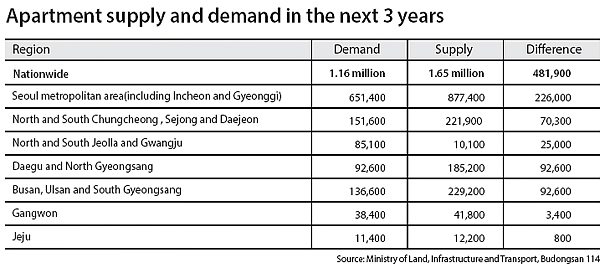Real estate market braces for oversupply

Prospective buyers queue outside the model house for the Hill State apartment complex on June 18. The Seoul metropolitan area is likely see the largest oversupply of residential units, an annual average of 390,000, in the next three years. [AHN JANG-WON]
Budongsan 114, a real estate information provider, estimates market supply in the next three years will total 1.65 million residential units. However, the government says demand will only reach 1.16 million units.
Of the expected supply, 1.02 million units will be in apartment buildings, and 630,000 units will be in low-rise multi-residential homes or single-unit houses. An additional 180,000 units are expected to be in officetels, dual-purpose buildings used for both commercial and residential purposes.
Since the end of last year, there has been growing concern about a possible oversupply of residential units that could bring about an economic downturn by lowering apartment prices.
The phenomenon is likely to differ by region. The Seoul Metropolitan Area, which includes the nation’s capital as well as the city of Incheon and province of Gyeonggi, will likely see the largest oversupply of housing units, an annual average of 390,000 units in the next three years.
The country’s southeastern area, which includes Busan, Ulsan and South Gyeongsang, is expected to suffer an oversupply of an annual average of 120,000 units, followed by the Daegu and North Gyeongsang area with 100,000 units.
The Chungcheong area, which includes the Chungcheong provinces as well as Daejeon and Sejong City, is expected to see an oversupply of 80,000 units, while the country’s southwestern Honam area, which includes the Jeolla provinces and Gwangju, estimates an oversupply of 30,000 units.

In the greater Seoul area as of the end of 2014, there were only enough units to accommodate 98.2 percent of the population, meaning there was a housing shortage in the region. Even if there is an oversupply of 340,000 units on average in the next three years, the impact will likely be limited.
However, outside the Seoul metropolitan area, the effects of oversupply are expected to be more severe. The real estate in Busan, Ulsan and South Gyeongsang can accommodate 107.1 percent of the population, while the real estate in Daegu and North Gyeongsang can accommodate 108.5 percent, meaning that housing supply has already exceeded the region’s need.
As of the end of 2014, the southeastern region of Busan, Ulsan and South Gyeongsang is already seeing an oversupply of 210,000 units, while the region of Daegu and North Gyeongsang is suffering an oversupply of 170,000 housing units.
“If there are more housing units that are provided in either Daegu or Busan than the average number of houses that are traded, the real estate market [in these areas] will be halted,” said Kim Seung-bae, CEO of Fides Development.
In the southwestern Honam region, which includes the Jeolla provinces and Gwanju, the housing supply can accommodate 110 percent of the population, though the oversupply there in the next three years is expected to be relatively smaller than that of other regions.
“The aftermath in areas where there has been huge interest by potential homebuyers due to favorable factors [that help apartment values rise after purchase] such as KTX and industrial development will be severe if the population moving in the area doesn’t meet its potential [resulting in a large number of unsold apartments],” said Kwon Dae-joong, a real estate professor at Myongji University.
BY AHN JANG-WON [lee.hojeong@joongang.co.kr]










with the Korea JoongAng Daily
To write comments, please log in to one of the accounts.
Standards Board Policy (0/250자)